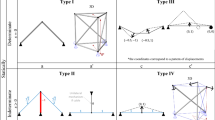Abstract
The current paper introduces a systematic method for representing and analysing coupled integrated engineering systems by means of general discrete mathematical models, called Combinatorial Representations, that can be conveniently implemented in computers. The combinatorial representation of this paper, which is based on graph theory, was previously shown to be useful in representing engineering systems from different engineering domains. Once all of the subsystems of an integrated multidisciplinary system are brought up to the common level of the combinatorial representation, they cease to be separated from one another and the analysis process is applied to all of the engineering elements disregarding the domain to which they belong.
During the development of the representation and study of its inherent properties, special attention was dedicated to developing an efficient analysis method. A vectorial extension of the mixed variable method known from electrical network theory was found to be the most suitable choice for this purpose.
In the paper, the approach is implemented by representing and analysing two systems: one that is a macro system comprised of truss, dynamic and electric elements, and another that is a comb-driven micro-resonator. The techniques presented in the paper are not limited to analysis only, but can be applied to many other aspects of engineering research. Among them is a systematic derivation of new ways of presenting engineering elements, one of which – the process of derivation of a new type of force representation entitled “face force” – is described in the paper.











Similar content being viewed by others
Abbreviations
- CR:
-
Combinatorial Representations
- FCFS:
-
Flow Controlled Flow Source
- FCPS:
-
Flow Controlled Potential difference Source
- FGR:
-
Flow Graph Representation
- MCA:
-
Multidisciplinary Combinatorial Approach
- PCFS:
-
Potential difference Controlled Flow Source
- PCPS:
-
Potential difference Controlled Potential difference Source
- PGR:
-
Potential Graph Representation
- RGR:
-
Resistance Graph Representation
References
Shai O (2001) The duality relation between mechanisms and trusses. Mech Mach Theory 36(3):343–369
Shai O (2001) The multidisciplinary combinatorial approach and its applications in engineering. AI EDAM 15(2):109–144
Shai O (2002) Utilization of the dualism between determinate trusses and mechanisms. Mech Mach Theory 37:1307–1323
Shai O (2001) Combinatorial Representations in Structural Analysis. J Comput Civil Eng 15(3):193 – 207
Seshu S, Reed MB (1961) Linear Graphs and Electrical Networks. Addison-Wesley, Boston, MA
Trent HM (1955) Isomorphisms between oriented linear graphs and lumped physical systems. J Acoust Society Am 27(3):500–527
Andrews GC (1971) The vector-network model – a topological approach to mechanics. PhD Thesis, University of Waterloo, Ontario, Canada
McPhee JJ (1996) On the use of linear graph theory in multibody system dynamics. Nonlinear Dynam 9:73–90
Fenves SJ, Branin FH (1963) Network topological formulation of structural analysis. J Struct Div-ASCE 89(ST4):483–514
Kaveh A (1997) Optimal structural analysis. Research Studies Press, Baldock, Hertfordshire, UK
Paul B (1960) A unified criterion for the degree of constraint of plane kinematic chains. J Appl Mech-T ASME 27:196–200
Dobrjanskyj L (1966) Application of graph theory to the structural classification of mechanisms. PhD Thesis, Columbia University, New York
Diaz-Calderon A (2000) A composable simulation environment to support the design of mechatronic systems. PhD Dissertation, Carnegie Mellon University, Pittsburgh, PA
Cha DP, Rosenberg JJ, Dym CL (2000) Fundamentals of modeling and analyzing engineering systems. Cambridge University Press, Cambridge, UK
Martens HR, Allen DR (1969) Introduction to systems theory. C.E. Merrill, Columbus, OH
Kron G (1963) Diakoptics – the piecewise solution of large-scale systems. Macdonald, London
Senturia S (2001) Microsystem design. Kluwer Academic, Boston, MA
Swamy MN, Thulasiraman K (1981) Graphs: networks and algorithms. Wiley, New York
Balabanian N, Bickart TA (1969) Electrical network theory. Wiley, New York
Shearer JL, Murphy AT, Richardson HH (1971) Introduction to system dynamics. Addison-Wesley, Boston, MA
Tang WC (1990) Electrostatic comb drive for resonant sensor and actuator applications. PhD Thesis, University of California, CA
Tilmans HAC (1996) Equivalent circuit representation of electromechanical transducers: I. Lumped-parameter systems. J Micromech Microeng 6:157–176
Acknowledgements
This research work was supported by the Fleishman Grant from the Engineering Faculty of Tel-Aviv University.
Author information
Authors and Affiliations
Corresponding author
Rights and permissions
About this article
Cite this article
Shai, O., Rubin, D. Representing and analysing integrated engineering systems through combinatorial representations. Engineering with Computers 19, 221–232 (2004). https://doi.org/10.1007/s00366-003-0262-2
Received:
Accepted:
Published:
Issue Date:
DOI: https://doi.org/10.1007/s00366-003-0262-2




